12 Best Types of Root Vegetables to Grow in Your Garden
Add flavor and variety to homecooked meals with these types of root vegetables that are easy to grow.
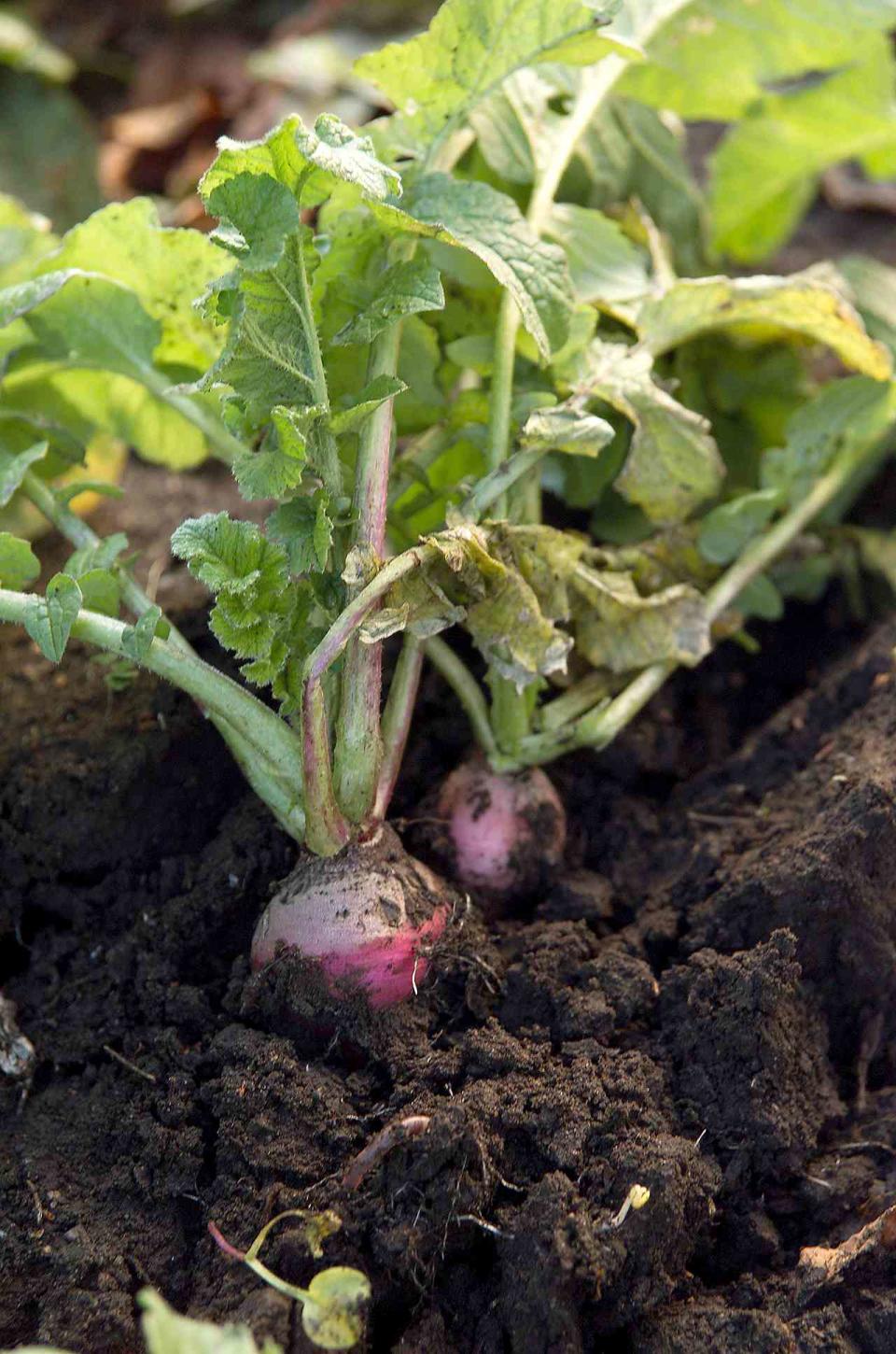
Root vegetables are mostly grown for their underground parts—tasty roots, tubers, rhizomes, bulbs, etc. These structures are packed with carbohydrates and water for the plants, and deliciousness for us. Some of these crops (let’s call them all roots to make it easier) such as potato, carrots and onions are staples in the kitchen. Others—horseradish, rutabaga, and salsify come to mind—are less common in most backyard veggie gardens, but they add wonderful variety and flavor to meals. Learn how to grow each tasty type of root vegetable with these must-know planting and harvesting tips.
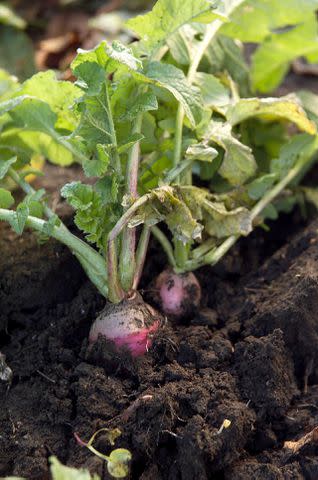
Beets
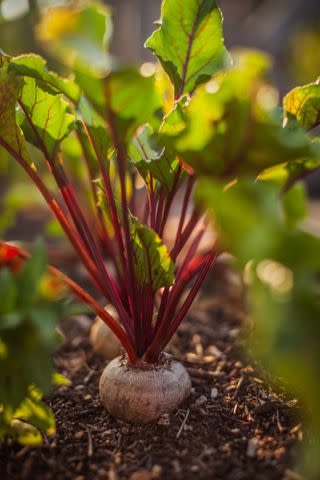
Bob Stefko
Beets are grown from seed planted directly in the garden from early spring to early summer and again in fall. To hasten germination, soak the seed overnight before planting. Sow 1 to 2 inches apart. Once the seedlings have grown a couple inches, thin to 3 to 4 inches apart. Keep plants evenly moist and weed-free; mulching helps keep the soil evenly moist, cool, and prevents weed growth.
Beets are ready to harvest once they reach golf ball size but can be left to grow larger. Beets are quite frost tolerant, and fall beets can be left in the ground to be harvested as needed until the ground freezes.
Related: 10 Best Companion Plants for Beets
Carrots
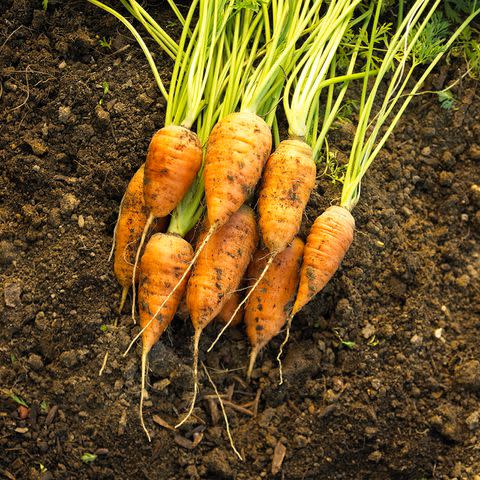
Carrots are a cool season crop that can be sown in spring and again in late summer for a fall or winter crop. Sow the seed directly in the garden, spacing seeds about an inch apart (or sprinkled thinly). The seeds are tiny and slow to germinate so it may be helpful to mix some radish seeds with the carrot seeds. The radishes make good companion plants because they germinate quickly to mark the row and help prevent soil crusting. The radishes will be almost ready to harvest when the carrots have just begun to grow.
Thin the carrots to about 2 inches apart and keep the soil evenly moist and well weeded. You can mulch to help retain moisture and suppress weeds. Small carrots can be harvested by pulling them individually. Larger carrots may require a garden fork to lift them without breaking the roots. Like beets, fall carrots can be left in the ground and harvested as needed until the soil freezes.
Garlic
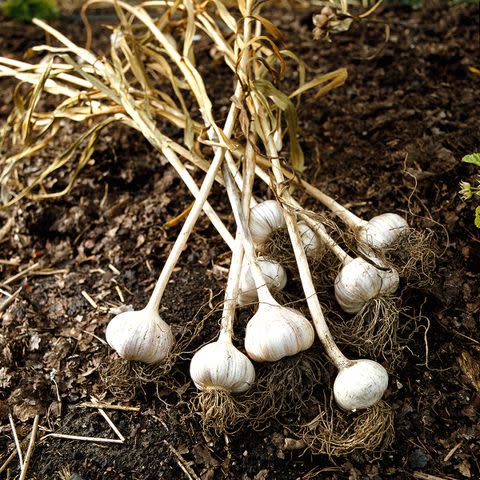
Garlic is a root crop in the sense that we harvest its edible underground structure, but technically that's a bulb, not a root. The bulb is composed of several “cloves,” which are separated and planted individually in the fall. Before planting, dig a trench 5 to 6 inches deep and add some bone meal or a balanced fertilizer in the furrow, then cover the fertilizer with about three inches of soil. Then set the garlic cloves—the pointed end upward—in the partly filled trench, spacing them 4 to 6 inches apart. Cover the cloves with soil and mulch well. If you are planting more than one row, space the rows 8 to 12 inches apart.
Garlic should be harvested the following summer when leaves begin to yellow and tops begin to fall over. If the soil is loose, pull by hand. If not, use a garden fork. Allow the bulbs to cure in an open area with good circulation for at least two weeks, until the outer layers of the bulb are very dry and papery. Brush off any loose dirt and cut the tops off, leaving an inch or 2 above the neck, or let the leaves remain and use them to braid the garlic into bunches. Store garlic in a cool, dark, dry place and check regularly for signs of rot.
Horseradish
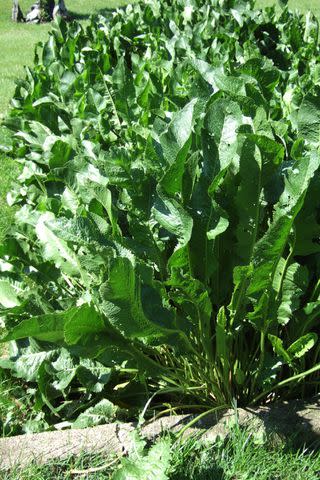
Denny Schrock
Horseradish has a very distinctive spicy flavor. It’s a hardy perennial vegetable that’s easy to grow but can be difficult to contain. If you plant it directly in the ground, keep it well away from other veggies, placing sets (small pieces of root) at a 45 degree angle, 3 to 4 inches deep and about 18 inches apart. To control its spread, plant horseradish in a submerged 5 gallon bucket with the bottom removed. Water regularly and control weeds.
The root of horseradish should be harvested in fall before the ground freezes. Refrigerate roots that you will use in a month or so. For long term storage, bury the root in moist sand in a cool, dark place. Grate or grind raw roots to add zesty flavor to fish, soups, sauces, dips, and more.
Related: Grilled Steak Salad with Fresh Horseradish Dressing
Onions
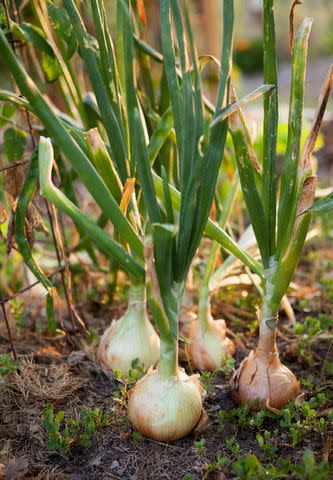
Onions can be grown from seeds, sets (small bulbs), or young seedlings. Onions planted from seed should be started indoors about 6 weeks before the last spring frost. Seedlings or sets can be ordered online or purchased from a garden center. These are typically planted in early spring as soon as the soil can be worked. Plant seedlings or sets in furrows 1 to 2 inches deep and 2 to 6 inches apart, depending on the type of onion you’re growing. Be sure to orient the set so its growing end is pointed upward. Cover with loose soil and water.
Harvest onions in dry weather when their leaves turn yellow and start to fall over—usually by mid to late summer. Allow the bulbs to dry for a couple days, either on the ground if the weather is dry or in a garage or covered porch. Once cured, store onions in a dark, dry location that remains between 40 and 60ºF. Check them regularly and remove any that show signs of rot.
If you want to store onions for extended use, select varieties known to store well. Sweet onions typically do not store for long.
Tips
Be sure to plant onion varieties that are suited to your region—onions are sensitive to daylength and their light requirements differ.
Parsnips
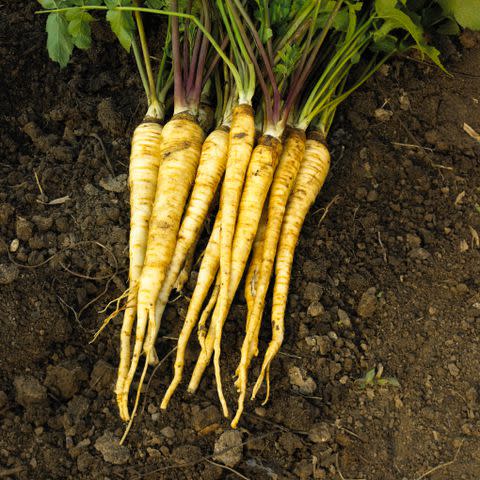
Marty Baldwin
Parsnips look like white carrots, but they have a distinctly nutty, sweet flavor. Roasted parsnips make a delicious side dish, or they can be chopped and added to soups and stews. Grown from seed, parsnips take a long time—about 16 weeks—to mature so should be planted mid to late spring for a fall crop.
Sow seed a half-inch deep and an inch apart, thinning to about 3 inches apart when seedlings are 1 to 2 inches tall. Keep the bed watered and weeded—mulching alongside the row will help keep soil moist and weeds down. As plants grow, hill the soil around the base to prevent the tops of the tap root from turning green.
Like many other cool season crops, the flavor of parsnips is improved with a few frosts. If you apply a thick layer of mulch, you can leave parsnips in the ground through winter, harvesting as needed until early spring.
Potatoes
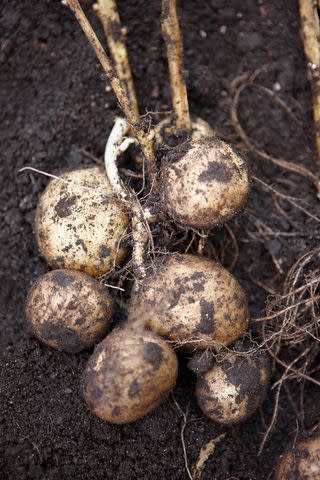
Marty Baldwin
Potatoes are grown from “seed pieces,” which are pieces of a tuber that has been cut to include at least 1 or 2 eyes or sprouts. This is another cool season crop, so plant the seed pieces in furrows in early spring. As the plants grow, mound soil around the base to provide lots of loose soil where the tubers will form.
If you love new potatoes, you can harvest young tubers by hand, leaving the rest of the plant to grow. Once the top of the potato plant dies back—usually early summer—carefully lift all the tubers using a garden fork. Any that are damaged during harvest should be used promptly. Depending on the variety, properly cured potatoes can be stored in the dark in a cool basement or garage for 2 to 4 months.
Radishes
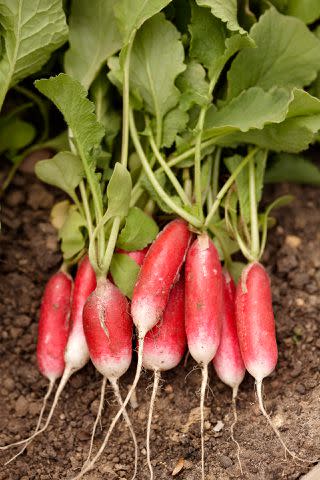
Radishes are a fast-growing cool season crop—often maturing in less than a month from seeding. They can be round or cylindrical in shape and they come in a variety of colors.
Sow radish seeds directly in the garden starting from early to late spring and again in fall. Once they are an inch or so tall, thin to the appropriate spacing suggested on the seed package (usually about 1 to 2 inches apart). Harvest frequently. The root often pushes its way partially out of the ground as it matures. Make several plantings two weeks apart for a steady supply.
Related: 10 Easy, Fast-Growing Vegetables You Can Harvest in Almost No Time
Rutabagas
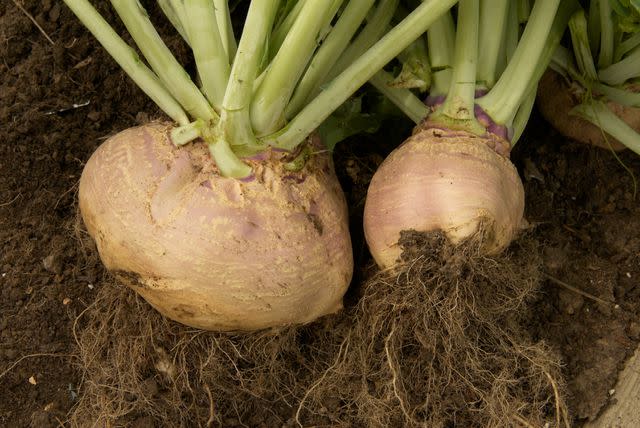
Dean Schoeppner
Similar to turnips but bigger, rutabagas are less frequently grown, but if you like to have a variety of fresh homegrown veggies well into fall and winter, they are a good choice. Also known as swedes, the bulbous roots can grow to the size of softballs. They make hearty additions to mixed root vegetable dishes.
Sow seeds about 90 days before you expect your first fall frost—that’s usually in mid-summer. Space them about 2 inches apart and a half-inch deep, thinning them to a final spacing of 6 inches apart. Keep them well watered and weeded. Harvest in the fall after the roots are 4 to 6 inches in diameter (the root tops are usually visible above ground). Their flavor is improved after a few frosts, and they can remain in the garden until the ground freezes. Once harvested, trim off the leaves and store the roots in a dark, cool—not freezing—location.
Salsify
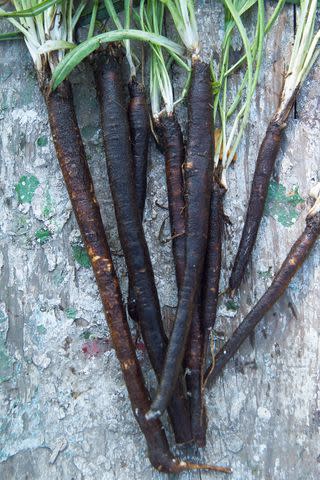
Marty Baldwin
Salsify, which forms a long, skinny tap root, has similar growth requirements to parsnip. It is also called oyster plant because its flavor reminds some people of oysters; others think it tastes a bit like artichoke hearts. The root can be boiled, roasted, mashed, or added to soups and stews.
Salsify takes 3 to 4 months to mature, so depending on where you garden, plant seed in spring or early summer for a fall harvest. In milder regions, a late summer planting can be harvested in winter. Sow seed a fourth-inch deep and an inch apart, thinning to 2 to 4 inches apart when seedlings are young. Mulch to suppress weeds and help retain soil moisture. The flavor of salsify is best after a few frosts, and like parsnips, the roots can be left in the ground under a thick layer of mulch to harvest throughout winter.
Sweet Potatoes
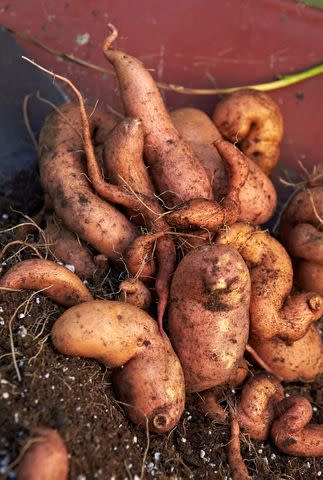
Sweet potatoes are technically tuberous roots and they are grown from “slips”—sprouts that develop from the roots. Slips are available in late spring from garden centers or online suppliers or you can start your own slips. This crop loves hot weather, so wait to plant the slips until 3 or 4 weeks after the last spring frost. They need a lot of room to grow, so plant each slip in a mound about 8 inches tall and space mounds 3 feet apart. These heavy feeders will appreciate a side-dressing of a balanced fertilizer about a month after planting.
Harvest sweet potatoes before the first frost, digging them carefully with a garden fork and handling them gently—they are easily bruised. Use damaged sweet potatoes promptly. To cure them for storage, remove loose dirt and place them in a warm place (around 80ºF) with high humidity. Once cured, they will store for several months in a cool room (55-60ºF).
Turnips

Turnips develop rounded roots with a cabbage-like flavor; they can be eaten raw or cooked. This cool season crop can be grown in spring or fall from seed planted directly in the garden. Sow seed one inch apart and about a fourth-inch deep. When seedlings are a few inches tall, thin to stand 4 to 6 inches apart. Keep soil moist and be sure to weed carefully; mulching will help keep weeds down.
Harvest small turnips to allow others to grow larger. Mulch fall grown turnips heavily and harvest as needed until the ground freezes.
Frequently Asked Questions
Can root vegetables grow in containers?
Most root crops can be grown in containers, as well as in raised beds if your garden soil is poor or rocky.
What's the best kind of soil for root vegetables?
Root vegetables share similar requirements for soil preparation and care. The ideal soil is loose, well-draining, and free of rocks. It’s a good idea to work some compost and a balanced, slow-release fertilizer into the soil to a depth of 10 to 12 inches before planting.
For more Better Homes & Gardens news, make sure to sign up for our newsletter!
Read the original article on Better Homes & Gardens.

